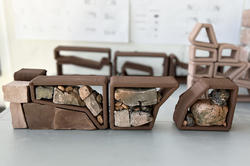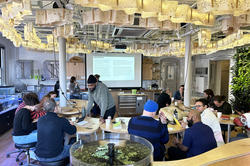Four ongoing research projects by faculty and recent alums focus on composting, improving the visual data used to drive climate research, sustainable biomaterials and tenants’ rights.
NSF Funds Research Collaboration between RISD and Partner Institutions

The National Science Foundation (NSF) recently awarded a $4 million Equitable Nature-Based Climate Solutions (ENACTS) grant for a four-year stormwater management project that will be conducted collaboratively at RISD, the University of Rhode Island, the University of New Hampshire, and the University of Louisville (KY). Landscape Architecture Department Head Johanna Barthmaier-Payne (pictured above, scanning plants with URI partner Madison Jones) will head up RISD’s contribution to the study, working with a team of transdisciplinary researchers to develop new protocols for gathering input from a diverse range of community members at each location.
Each of these “living hubs” has experienced intense rainfall, early spring melt, warmer temperatures, flooding and seasonal droughts caused by climate change. Rapid residential and commercial development using impervious surfaces exacerbates these problems and disproportionately affects vulnerable populations.
The grant is one of three new NSF awards secured by RISD Research. In addition to the $515,000 that RISD will receive over four years via the ENACTS grant, the Edna W. Lawrence Nature Lab will benefit from a four-year, $709,000 ECORE grant, and Director of Research Soul Brown will lead a $505,000 GRANTED project next summer in partnership with Roger Williams University, Providence College, Rhode Island College and Salve Regina University.

As Brown explains, the NSF is widening the scope of research projects it supports to include different kinds of expertise—such as Indigenous knowledge—alongside traditional, lab-based empirical science. “With the ENACTS project, Johanna is opening the process up to include substantive, authentic engagement with different kinds of people from the community,” she adds.
The design principles of socially equitable nature-based solutions will be explored through landscape and spatiotemporal perspectives. As Barthmaier-Payne explains, nature-based projects are often misunderstood, especially in underrepresented communities, because there are limited examples of these projects to learn from and few positive experiences that acknowledge a wide range of cultural values.
“The design process is not as transparent as it could be,” she adds, “and designers frequently operate in a kind of gatekeeper role. We’re trying to collect as many voices as possible. Even though it takes more time to involve community members, the end results are usually more widely accepted and valued.”

The first challenge, says Barthmaier-Payne, is building trust and rapport with the stakeholders at each living hub and learning about how they experience their neighborhoods, parks and other public spaces affected by climate change. The team will employ inclusive data-gathering techniques like listening sessions and story mapping—the collection of community experiences via a visual diagram or map—which typically draw wider participation than traditional surveys and focus groups.
Community members will then develop a user-friendly AR platform that non-designers will be able to use to mitigate climate-related issues in their neighborhoods. “It will give users site-specific instructions and costs, including what plants to consider, what tools they’ll need to get the job done and how much stormwater they need to capture,” says Barthmaier-Payne. “We need to teach people how to use the platform and how to make it their own.”
“Municipalities are looking towards nature-based solutions because they don’t require complex construction, they’re not as expensive to implement and they work really well.”
They can use it to plan, for example, low-lying rain gardens, retention ponds or tree filters. The tool might help them consider planting shade trees, use LiDAR scanning to check the area’s topology, underlying watersheds and hydrological conditions, or select appropriate materials and placemaking amenities like walking paths and park benches.
“Each community hub has its own distinct character and challenges,” says Barthmaier-Payne, “but they are all facing similar problems. Municipalities are looking towards nature-based solutions because they don’t require complex construction, they’re not as expensive to implement and they work really well.”
Eight RISD grad students in the Landscape Architecture department will contribute to the project, and Barthmaier-Payne hopes to offer related studios in the coming academic years that will feed into the research. “The overarching goal,” she says, “is to conceive design principles and best practices that promote equity alongside sustainability, resilience and practicality.”
Top photo: Barthmaier-Payne and URI research collaborator Madison Jones scan plants, which will be transformed into models for a digital library for the new AR platform they are developing.
Simone Solondz
September 19, 2024


